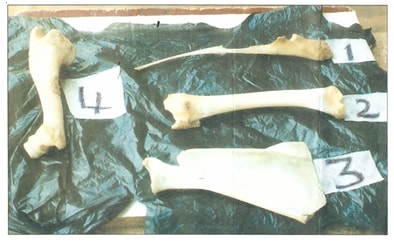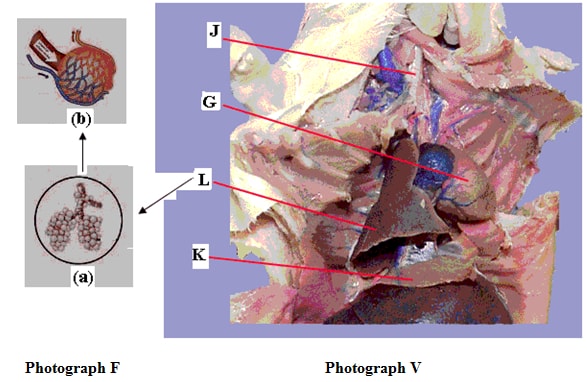INSTRUCTIONS TO CANDIDATES
- Answer ALL questions in the spaces provided in the question paper.
- You are not allowed to start working with the apparatus for the first 15 minutes of the 1 3/4 hours allowed for this paper. This time is to enable you to read the question paper and make sure you have all the chemicals and apparatus that you may need.
- The diagram below shows bones obtained from the same mammal.

- Give the identity of each of the above bones. (4 marks)
- Draw a diagram of the bones, arranged as they appear in the mammal from which they were obtained from. (3 marks)
- On your diagram indicate by naming the types of joints between the bones. (2 marks)
-
- Give three adaptations of bone labeled 3 to its functions. (3 marks)
- Give three adaptations of bone labeled 4 to its functions (4 marks)
- You are provided with solution labeled J, use the reagents provided to test for the food substances.
- Use the iodine solution to test for the food substance in solution J.
- Food substance (1 mark)
- Procedure (1 mark)
- Observation (1 mark)
- Conclusion (1 mark)
- Use Benedict’s solution to test for the presence of the food substance in solution J.
- Food substance (1 mark)
- Procedure (1 mark)
- Observation (1 mark)
- Conclusion (1 mark)
- Use DCPIP solution provided to test for the presence of the food substance in solution J
- Food substance (1 mark)
- Procedure (1 mark)
- Observation (1 mark)
- Conclusion (1 mark)
- When testing for non-reducing sugars explain the role of the following substances.
- Dilute hydrochloric acid. (1 mark)
- Sodium hydrogen carbonate (1 mark)
- Use the iodine solution to test for the food substance in solution J.
- Study photograph labeled V which is a display of internal organs of a small mammal. Photograph F is an inset of internal structure of part labeled L. Study them carefully.

- Name the part of the mammalian body where the organs shown in the photograph are found. (1 mark)
- Identify the organ system that consists of parts J and L in the photographs. (1 mark)
-
- Name the parts labelled J and K. (2 marks)
- Give the function of the part labelled G. (1 mark)
- State two adaptations of organ in L to its functions (2 marks)
- F (a) is an inset of the internal structure of part L showing the position of the functional units of L. One of these functional units is shown in the inset F (b).
- Identify the functional unit shown in inset F(b) and give its function. (2 marks)
Identity:
Function: - Give one observable feature in the structure you have named in (e)(i) above that adapt it to its function. (1 mark)
- Identify the functional unit shown in inset F(b) and give its function. (2 marks)

MARKING SCHEME
-
- 1 - Ulna
2 - Radius
3 - Scapula
4 - Humerus -
-
-
- Broad and flattened surface to provide a large surface area for attachment of shoulder muscles; rej flat
- Has a spine to increase surface area for muscle attachment;
- Has a glenoid cavity for articulating with the head of humerus; rej joining for articulation
- Has coracoid process for attachment of ligaments that connect it to the humerus; (Any three)
-
- Has a long shaft to act as a lever for easy movement of the limb
- Has a long shaft to provide a large surface area for attachment of biceps and triceps muscles;
- Has a head (ball) for articulating with the scapula to form a ball and socket joint;
- Has trochlea at one end for articulating with the sigmoid notch of the ulna;
- Has olecranon fosa into which the olecranon process on the ulna fits to stop overstretching of the lower arm backwards. (Any 2)
-
- 1 - Ulna
-
-
- Food substance; Starch;
- Procedure; Add iodine solution to J
- Observation; Blue- Black/ black/ blue colour is observed; rej. Bluish/blackish
- Conclusion; Starch present;
-
- Food substance; Reducing sugar
- Procedure; To solution J, add Benedict’s solution, Boil Rej . benedicts/Benedicts, warm for boiling ( in a water bath)
- Observation; The colour remains blue/ blue colour persists; rej No Change
- Conclusion: Reducing sugar absent;
-
- Food substance; Vitamin C/ Ascorbic acid;
- Procedure: Add solution J into DCPIP; drop by drop. Rej. Without drop by drop
- Observation: DCPIP is decolourised;
- Conclusion: Vitamin c/ Ascorbic acid present;
-
- to hydrolise any disaccharide present.
- to neutralize excess hydrochloric acid. rej. Without excess.
-
-
- Thorax/Thoracic region/Thoracic cavity; Rej chest
- Gaseous exchange system; Rej Respiratory system.
-
- J: Trachea; Rej wind pipe K: Diaphragm;
- Pumping blood to various parts of the body;
-
- Highly vascularised in alveoli for gases to diffuse and get transported;
- Spongy to accommodate more air; Acc. elastic
- Numerous alveoli to increase surface area for maximum gaseous exchange;
- Well ventilated/connected to bronchus/bronchioles to allow free movement of gases in and out during breathing;
- Has alveoli with moist lining where gases dissolve to facilitate gaseous exchange due to their rapid diffusion; (1st two)
-
- Identity: Alveolus; Rej alveoli, air sac
Function: The surface in the lungs where gaseous exchange occurs; -
Highly vascularised for gases to diffuse into to enhance their transportation; Well ventilated to enhance movement of gases in and out; (1st one)
- Identity: Alveolus; Rej alveoli, air sac
Download BIOLOGY PAPER 3 - 2019 KCSE STAREHE MOCK EXAMS (QUESTIONS AND ANSWERS).
Tap Here to Download for 50/-
Get on WhatsApp for 50/-
Why download?
- ✔ To read offline at any time.
- ✔ To Print at your convenience
- ✔ Share Easily with Friends / Students


